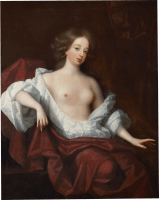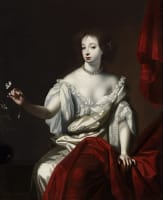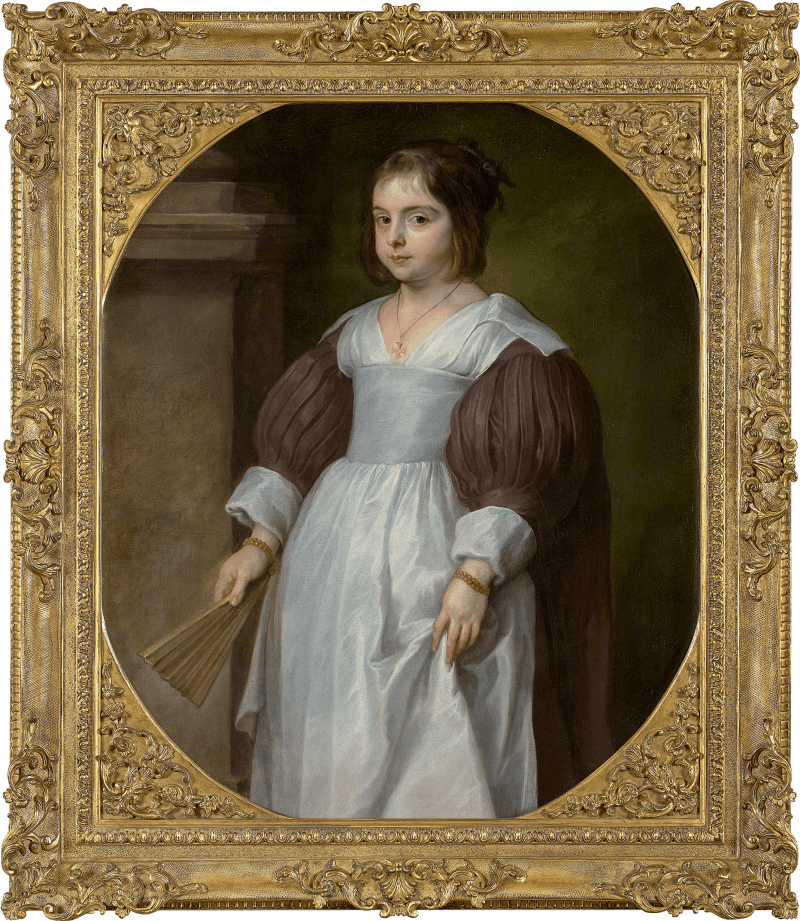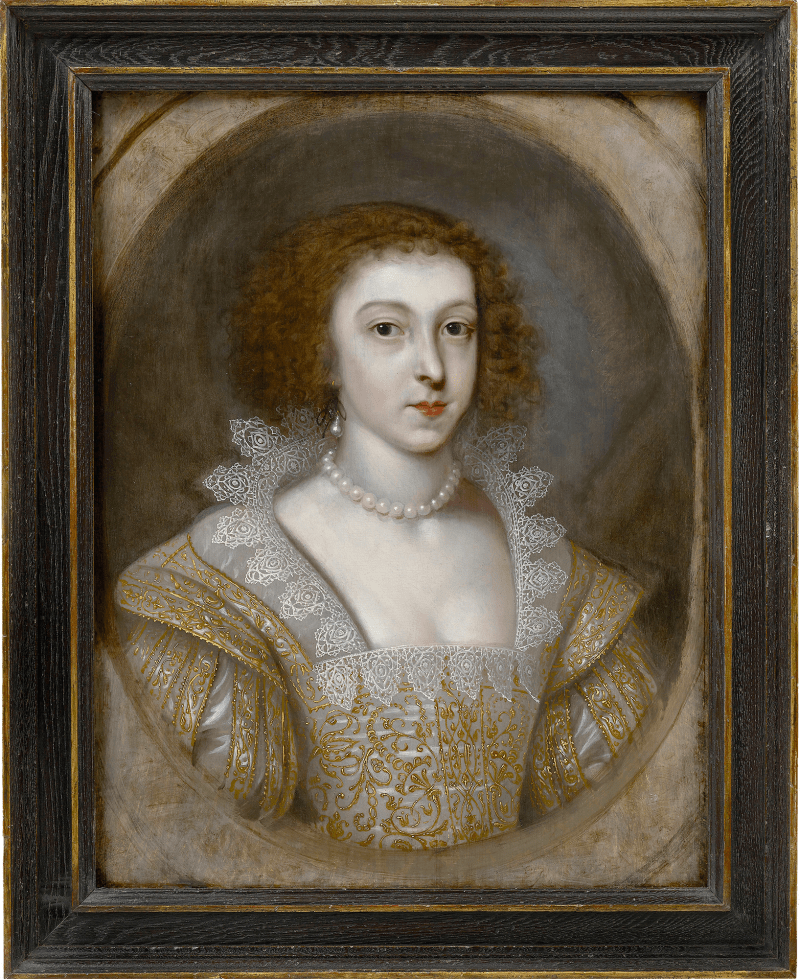Described as ‘The indiscreetest and wildest creature that ever was in a Court’ Nell Gwyn was the favourite mistress of King Charles II and one of the most colourful characters of the Restoration age. Her famous beauty and humble origins endeared her to the British public and her close relationship with the King has led biographers to declare her ‘the real Queen of Restoration England’.[1] The present work was painted in the 1670s when Gwyn was at the height of her fame and was possibly commissioned by her friend and supporter George Villiers, 2nd Duke of Buckingham.
Gwyn’s popularity amongst the general public and her prominent position at court led to the high demand and wide dissemination of her image in painted and printed form. However, since her death, Gwyn’s iconography has become muddled, and a proliferation of portraits showing unknown, sultry-looking Stuart beauties continue to be incorrectly identified as her. Of all the surviving painted portraits which can...
Described as ‘The indiscreetest and wildest creature that ever was in a Court’ Nell Gwyn was the favourite mistress of King Charles II and one of the most colourful characters of the Restoration age. Her famous beauty and humble origins endeared her to the British public and her close relationship with the King has led biographers to declare her ‘the real Queen of Restoration England’.[1] The present work was painted in the 1670s when Gwyn was at the height of her fame and was possibly commissioned by her friend and supporter George Villiers, 2nd Duke of Buckingham.
Gwyn’s popularity amongst the general public and her prominent position at court led to the high demand and wide dissemination of her image in painted and printed form. However, since her death, Gwyn’s iconography has become muddled, and a proliferation of portraits showing unknown, sultry-looking Stuart beauties continue to be incorrectly identified as her. Of all the surviving painted portraits which can be securely identified as Gwyn, it is those by the Dutch artist Simon Verelst, which combine drama, elegance, and eroticism, that have remained the most enduring and continue to intrigue and surprise viewers to this day.
Verelst’s preference for strong, theatrical lighting would certainly have appealed to Gwyn who became one of the most celebrated actresses in London following the Restoration of King Charles II. Life had not always been so glamourous for Gwyn, however, and she is said to have been raised in a ‘bawdy house’, where it can be presumed her mother was a prostitute.[2] By 1663 she was an orange-seller at the Bridges Street Theatre with Mary Meggs, an eccentric and lively woman known as ‘Orange Moll’.[3] Gwyn could not have been an orange seller for more than eighteen months, as in 1664, at the age of fourteen, she made her stage debut. She soon became a familiar face on the entertainment circuit and is frequently mentioned in the diaries of Samuel Pepys, who in April 1665 noticed ‘pretty witty Nell’ in the audience at the King’s House theatre on Drury Lane.[4] Gwyn gained further fame following her role as Florimell in John Dryden’s Maiden Queen (1667), with Pepys describing her comical role as one ‘…that I never can hope ever to see the like done again, by man or woman.’[5] It was around this time that Gwyn caught the attention of the king and by 1668 they were meeting in private - ‘the King did send several times for Nelly’, according to Pepys[6]. The following year she became pregnant with their first child and soon after she retired from acting, returning to the stage only briefly in 1670/71 to star in Dryden's The Conquest of Granada. By the end of 1671, Gwyn had born a second son with Charles and was living in a grand house on Pall Mall which backed onto St James’s Park allowing for discreet visits from the king. Although illegitimate, Gwyn’s two sons solidified her relationship with the monarchy, and a few years later she was awarded a pension of £4,000 per year (increasing to £5,000 in 1676) as well as property at Windsor and further leases of land. Her sons were also granted titles; Charles was given the surname Beauclerk and created Baron Heddington and earl of Burford in 1676 and his younger brother was granted the courtesy title Lord Beauclerk. This increase in status was a hard-fought battle and for every supporter, there were swathes of courtiers who disliked and disapproved of Gwyn’s rise to prominence.
Rarely one to conceal her feelings beneath a veil of respectability, Gwyn would often respond with vigour to those who slighted her. In one instance, after receiving a cold reception from a rival mistress Barbara Villiers, Duchess of Cleveland, Gwyn is said to have ‘clapt her on the shoulder, and saide she perceaved that persons of one trade loved not one another’.[7] This retort would have seemed all the more insulting given Cleveland’s noble lineage which by the standards of the time made her position more respectable than Gwyn’s. On another occasion, Charles is said to have asked her how best to reassure parliament about his new (and unpopular) French mistress Louise de Kéroualle, Duchess of Portsmouth to which she replied ‘hang up…the French bitch’.[8] She later doubled down on her dislike towards Portsmouth and requested from the French ambassador that King Louis XIV send her a present as she serves Charles better than the Frenchwoman.[9] Gwyn’s famously sharp tongue and outspoken views naturally align with the image of her presented in this portrait which is frank and intentionally provocative.
Nudity was highly unusual in formal portraiture from this period and does not appear to have been an acceptable mode of expression for anyone other than mistresses.[10] And that is not to say that all mistresses wished to be portrayed in such a manner – in fact, most of the King’s favourite women were portrayed in a way not dissimilar to their noble peers, albeit with a flirtatious twist of the hair or a low-cut dress. Gwyn, however, was less coy about her status and embraced her position with great bravado, playing up to the role, as seen here, with defiant self-assurance. Far from shy, she makes direct eye contact with the viewer, who is left wondering if she is challenging or encouraging their curious glances.[11]
Even within the context of Gwyn’s iconography, the present work is startlingly unabashed and is one of only two surviving variants of this type; the other is on a reduced scale and is currently on display at the National Portrait Gallery (fig.1).[12] In Gwyn’s other portraits by Verelst, such as the bust-length example in the permanent collection at the National Portrait Gallery, her breasts are only partially exposed with her left nipple just visible beneath her falling undergarment. A further three-quarter length example with the same head-type as the aforementioned work was previously handled by Philip Mould & Company and likewise shows Gwyn only partially exposed with a white flower in her outstretched hand (fig.2). The only other portrait of Gwyn by Verelst which shows her breasts fully exposed is that which depicts her in the guise of Diana running through a forest (fig.3). This latter work is more theatrical and lacks the sensual intimacy of the present example which was presumably commissioned for a friend or other close ally.
Although we do not know for certain who commissioned the present work, it was almost certainly the same portrait that was engraved by Valentine Green in 1777. An inscription on the engraving states it was taken ‘From an Original Picture in the Collection of the Late Duke of Buckingham’ although it is unclear if this refers to a duke from the second or third creation of the dukedom. The second creation became extinct in 1687 with the death of George Villiers, 2nd Duke of Buckingham (1628–1687), and the third creation, the double dukedom of Buckingham and Normanby, became extinct in 1735 on the death of the second duke, Edmund Sheffield.
The Dukes of Buckingham were engraved by Valentine Green in 1777 (fig.4). Indeed, the antiquarian George Vertue (1684-1756) states that it was George Villiers, 2nd Duke of Buckingham who brought Verelst into vogue and encouraged him to take up ‘face-painting’ alongside his still-life work. We know that Buckingham and Gwyn enjoyed a close relationship with the former acting as Nell’s unofficial manager when trying to secure the attention and affections of the king. The arrangement was by accounts successful and once Gwyn was installed Buckingham is said to have kept a close eye on all possible usurpers, protecting and progressing, of course, his interests as well as hers. This close relationship later came in use when in 1677 Buckingham was sent to the tower after attempting to dissolve parliament; it was only due to Gwyn’s intervention that the king accepted his apology, and he was released. Their intimate friendship endured and in 1679 Buckingham is recorded as lodging with Gwyn at 79 Pall Mall, an arrangement which ‘…doth not a little contribute to the jealousies and dissatisfactions of the people’, according to one commentator of the time.[13]
When Gwyn’s elder son was granted the dukedom of St Albans in 1684 her status was all but secured and were it not for Charles’s death the following year, Gwyn too might have realised her ultimate ambition of receiving a title. Gwyn outlived Charles by only two years and was supported by James II who settled her debts and continued her pension, lending credence to the oft-repeated claim that Charles’s final words were ‘Let not poor Nelly starve’.[14]
[1] MacGregor-Hastie, R (1987) Nell Gwyn. London: Robert Hale Ltd, p. 12
[2] Beauclerk, C (2005) Nell Gwyn: A Biography. London: Pan Books, p.15
[3] Perry, G (2011) ‘Introduction: Painting Actresses Lives’ in The First Actresses: Nell Gwyn to Sarah Siddons. London: National Portrait Gallery, p.35. Evidence for Nell Gwyn selling oranges: ‘A Ballad Called the Haymarket Hectors’ from 1671 taken from Meilville, L (1900) Nell Gwyn: The Story of her Life. London, p.206; a single folio sheet 1681, ‘A pleasant Battle between Tutty and Snapshort, the two lap-Dogs of the Utopian court’; and a poem attributed to Lord Rochester from Cunningham, P (1908) Story of Nell Gwyn. Edinburgh, p.6
[4] The Diary of Samuel Pepys, Monday 3rd April 1665 [online]. Available at https://www.pepysdiary.com/dia... (Accessed 3 August 2023)
[5] The Diary of Samuel Pepys, Saturday 2nd March 1666/7 [online]. Available at https://www.pepysdiary.com/dia... (Accessed 3 August 2023)
[6] The Diary of Samuel Pepys, Saturday 11th January 1667/8 [online]. Available at https://www.pepysdiary.com/dia... (Accessed 3 August 2023)
[7] Sir Francis Fane's commonplace book, Shakespeare Birthplace Trust RO, Stratford upon Avon, ER 93/2, quoted in Wynne, S. M. ‘Gwyn, Eleanor [Nell] (1651?–1687), actress and royal mistress.’ Oxford Dictionary of National Biography. 23 Sep. 2004 [online]. Available at https://www-oxforddnb-com.lonlib.idm.oclc.org/view/10.1093/ref:odnb/9780198614128.001.0001/odnb-9780198614128-e-11816 (Accessed 3 August 2023)
[8] Ibid.
[9] Wynne, S. M. ‘Gwyn, Eleanor [Nell] (1651?–1687), actress and royal mistress.’ Oxford Dictionary of National Biography. 23 Sep. 2004 [online]. Available at https://www-oxforddnb-com.lonlib.idm.oclc.org/view/10.1093/ref:odnb/9780198614128.001.0001/odnb-9780198614128-e-11816 (Accessed 3 August 2023)
[10] Macleod, C and Alexander, J.M. (eds) (2001) Painted Ladies: Women at the Court of Charles II. London: National Portrait Gallery, p. 168
[11] It was not just Verelst to whom Gwyn posed bare-chested; an engraving after a now-lost work by the French artist Henri Gascars shows her reclining in a landscape with her two sons in the guise of cupids. The latter work, however, is more theatrical with Gwyn shown in a Venus-like pose and unlike the present work was engraved and dispersed within Gwyn’s lifetime.
[12] NPG L248
[13] Quoted in Macgregor-Hastie, R. (1987) Nell Gwyn. London: Robert Hale, p. 157.
[14] Burnet, Sir T. (ed.) (1753) Bishop Burnet’s History of His Own Time. London: A. Millar, Vol. 2, p. 283



















